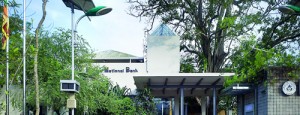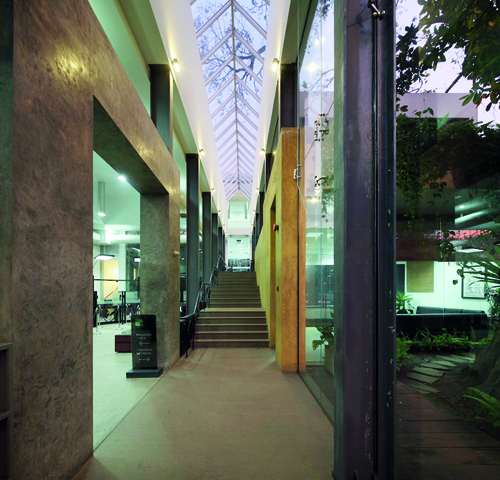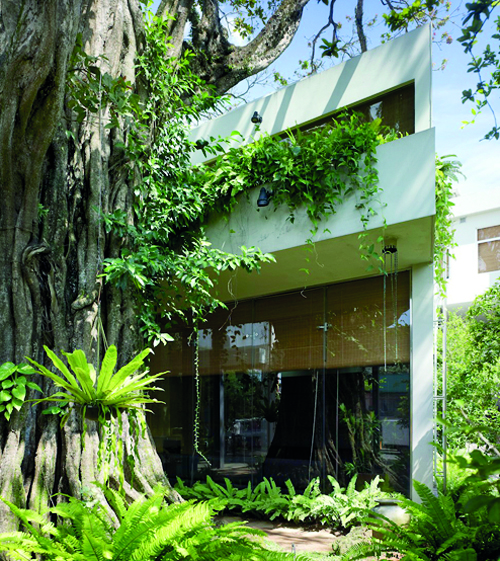Banking on a tree house look
A frequent traveller on the A1 Kandy-Colombo road will know the distinctive Nittambuwa branch of the Hatton National Bank which today holds the distinction of being Sri Lanka’s first ‘green’ bank building; a mean, green machine that saves 30% more electricity and 70% more water than its counterparts, with 90% of its construction waste directed towards other uses. For a structure that finds its  focal point in a towering, century-old tree this seems like a natural transition. For the man behind the project, Architect Suranjan Ranasinghe, it’s a career first and a massive personal accomplishment.
focal point in a towering, century-old tree this seems like a natural transition. For the man behind the project, Architect Suranjan Ranasinghe, it’s a career first and a massive personal accomplishment.

Archt. Suranjan Ranasinghe
Educated at Maris Stella College, Negombo, the young Ranasinghe had initially planned a career in civil engineering. “Architecture was never on the cards for me,” he explains. “I picked it up along the way, and now I greatly enjoy it.” He obtained both a Bachelors and Masters in Architecture from the University of Moratuwa and in the early ’90s embarked on a partnership, having earlier apprenticed with Architect A.S. Kulasinghe, where he learnt quite a bit about the profession. Having obtained his Chartered qualification, Ranasinghe established his own practice- Archiform Design Consultants based in Negombo.

Long skylight: Natural light filtering in and inset;
The Hatton National Bank is an old client of Ranasinghe’s, which means he knew the management well enough to know that they would want only the highest standards in design for their new ‘green bank’ venture. “I had never designed a green structure before,” says Ranasinghe. “Being the first of its kind when it comes to the banking industry, there was not much to base my work on either so the designing process involved quite a bit of research and consultation with our green consultants EnergySolve International, and construction partners Tudawe Brothers.”
Ranasinghe’s primary specification was to keep to the standards specified by the United States Green Building Council, known as a LEED (Leadership in Energy and Environmental Design) Certification. The certification system adopts a holistic approach to eco-friendly design and specifies five major codes for designers to live by. These include; sustainable site planning, water efficiency, energy efficiency, conservation of materials and resources and indoor environment quality. In addition, innovative design is also championed by the code.
With the initial planning a significant obstacle the architect faced was in the uneven slope of the land. He has dealt with this by designing the bank in corresponding levels, such that a glance out of the window will reveal only smooth planes and lush greenery. The top soil was segregated and reused for landscaping, the goal being to keep the existing vegetation as it was whenever possible.
He uses cast off materials to construct the stairways; Forest Stewardship Certified Timber melds with steel cut-offs from construction to form an interesting pathway leading into the second level of sorts, the airy, utterly captivating manager’s office overlooking the big  tree in the front park. The effect seems that of a rather upscale and modern treehouse, for the office almost nestles against the massive tree’s branches.
tree in the front park. The effect seems that of a rather upscale and modern treehouse, for the office almost nestles against the massive tree’s branches.
The bank’s commercial areas including reception and the front offices are furnished simply, in keeping with the earthy browns and greys of the building. The only diversion comes in the form of two truant walls-one yellow, and the other blue, but both are upstairs so if you’re a customer it’s unlikely you’ll spot these.
The lighting and ventilation systems use innovative new tools to make maximum use of nature’s bounty. On a sunny day the entire building can function without the operation of a single electric lamp.
This is achieved with the use of solar tubes that concentrate sunlight received from outside to illuminate the building. Intelligent lighting and ventilation systems in most areas of the building ensure energy conservation. It’s not all hi-tech gadgetry either-simple measures like full length windows and abundant greenery contribute to the effect.
The building, in addition to a Gold LEED Certification, has also been awarded several other accolades; the Silver Flame Award at the Sri Lanka National Energy Efficiency Awards conducted by the Sustainable Energy Authority in 2012, a Green Construction Excellence Award from the Institution for Construction Training and Development (ICTAD), and a Design Award given by the Sri Lanka Institute of Architects in 2014. Ranasinghe, on his end, is just pleased to have done so well with this first foray into green design. He applauds the bank management’s decision to go green, despite the cost burden generally associated with such a measure. “The time is right for visionary, eco-friendly design,” he says.
The structure blends in so well with its surroundings that we’re told the birds of the area have set up residence in some trees thriving indoors. HNB named this building ‘Haritha Kedalla’ (Green Home); walking through its earthy halls, lit by a dreamy skylight that spans the building, we can’t help but think this is a name well deserved.


